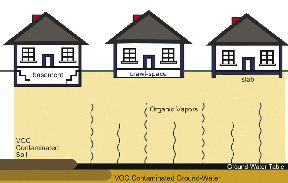Vapor intrusion (VI) has emerged as a significant environmental liability for property owners, prospective purchasers and lenders during real estate transactions. Dangerous chemicals from contaminated soil and ground water can migrate into structures as vapor and create significant liability and impact property value. These chemicals may be present in spills of cleaners, petroleum, and solvents that are used in industry as well as common household products. This exposure pathway can cause Sick Building Syndrome. A qualified environmental professional should be retained during real estate transactions to determine whether a property has the potential for vapor intrusion issues.
VI has attracted increased focus by regulatory agencies and the potential liabilities can be significant. Even after cleanup of a site has been approved by environmental regulatory agencies, they have the authority to require further investigation, and possibly remediation, of newly discovered VI impacts. VI can also result in reopening of voluntary and brownfield cleanup agreements. In addition, some local health departments have statutory authority to require a facility to address the contamination regardless of any prior site cleanup approvals that may have been granted by state or federal environmental agencies. New York State recently reopened more than 400 formerly closed sites due to suspected vapor intrusion contamination. Regulatory reopeners can also precipitate the following liabilities for current and past property owners.
* Potential tenant suits.
* Tenants breaking leases because of unhealthy indoor air.
* Inability to attract new tenants.
* Property devaluation.
* Lawsuits against past property owners for non-disclosure or misrepresentation.
* Impact on borrower's creditworthiness and ability to repay loan.
* Foreclosure complications.
The ASTM (American Society for Testing and Materials) recently released a new standard (E 2600) called Assessment of Vapor Intrusion into Structures on Property Involved in Real Estate Transactions. This standard provides guidance for vapor intrusion testing and defines good commercial and customary practice for conducting a vapor intrusion assessment. The intent of the standard is to provide parties to real estate transactions information on which they can rely to determine whether or not there is a reasonable probability that vapor intrusion could present environmental liability. For commercial real estate transactions, a vapor intrusion investigation can be used independently or as a supplement to ASTM E 1527, the Standard Practice for the Phase I Environmental Site Assessment Process.
A qualified environmental professional is needed to determine whether VI impacts are attributable to the facility, or whether another business may be the source. This involves a review of prior remediation reports and data, and may also involve environmental testing to determine potential migration pathways.
Timeliness for completion of environmental due diligence is often more important than investigation or mitigation costs during real estate transactions. Parties to the real estate transaction do not need to proceed sequentially through all tiers of investigation that are outlined in the standard. In some cases, a property owner may decide to go directly to Tier 4 (pre-emptive mitigation) for precautionary reasons. However, in most cases, it is expected to be more cost effective if sufficient time is available to conduct at a minimum a Tier 1 screening evaluation and, if necessary, a Tier 2 screening evaluation before proceeding to a more costly and time-consuming Tier 3 investigation or to Tier 4 mitigation. The essence of the ASTM E 2600 standard is to provide a basis for informed decision making regarding environmental risk associated with vapor intrusion. Effective actions to protect parties to a real estate transaction from this environmental liability can only be implemented after the problem is fully investigated and understood.
Keith Shortsleeve, PG, LEP, CHMM is an associate at Leggette, Brashears & Graham, Inc., Farmington, Conn.
Tags:
Vapor intrusion emerges as environmental liability during real estate transactions
May 15, 2008 - Connecticut










